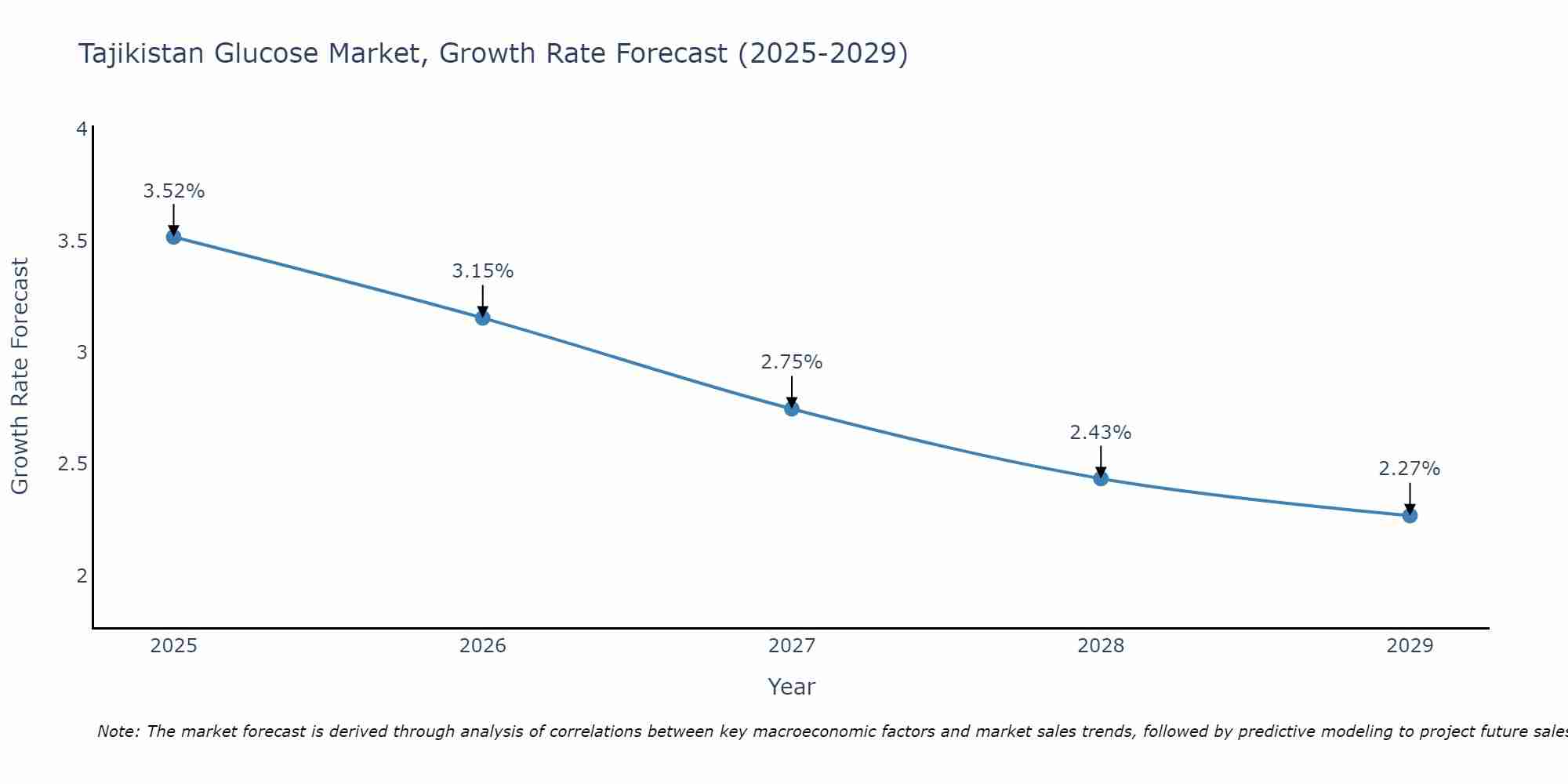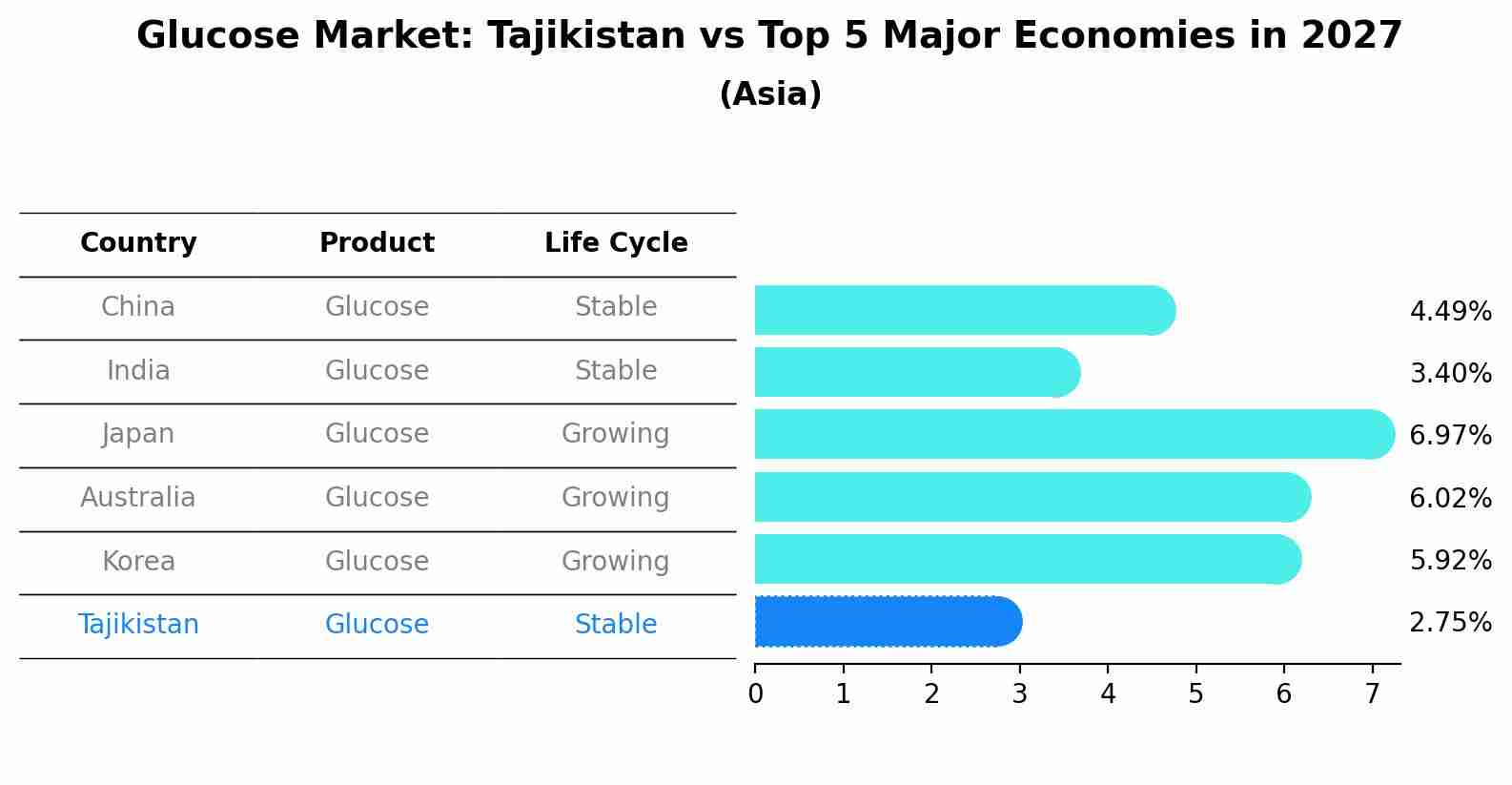Tajikistan Glucose Market (2025-2031) Outlook | Value, Revenue, Trends, Size, Analysis, Growth, Industry, Share, Companies & Forecast
| Product Code: ETC126009 | Publication Date: Jun 2021 | Updated Date: Jun 2025 | Product Type: Report | |
| Publisher: 6Wresearch | Author: Shubham Deep | No. of Pages: 70 | No. of Figures: 35 | No. of Tables: 5 |
Tajikistan Glucose Market Size Growth Rate
The Tajikistan Glucose Market may undergo a gradual slowdown in growth rates between 2025 and 2029. Although the growth rate starts strong at 3.52% in 2025, it steadily loses momentum, ending at 2.27% by 2029.

Glucose Market: Tajikistan vs Top 5 Major Economies in 2027 (Asia)
In the Asia region, the Glucose market in Tajikistan is projected to expand at a stable growth rate of 2.75% by 2027. The largest economy is China, followed by India, Japan, Australia and South Korea.

Tajikistan Glucose Market Overview
The Tajikistan Glucose Market is witnessing steady growth due to an increasing awareness of health and wellness among the population. Glucose products are widely consumed in the country as a source of quick energy and are popular among athletes, students, and individuals looking for a convenient energy boost. The market is primarily dominated by local manufacturers who offer a variety of glucose-based products such as energy drinks, glucose tablets, and glucose powder. With the rising disposable income and changing consumer preferences towards healthier alternatives, there is a growing demand for glucose products with natural ingredients and reduced sugar content. The market is also influenced by factors such as changing lifestyle patterns, urbanization, and the growing trend of fitness and sports activities among the population.
Tajikistan Glucose Market Trends
The Tajikistan glucose market is experiencing steady growth due to increasing awareness about health and wellness, leading to a higher demand for low-calorie sweeteners. Consumers are seeking healthier alternatives to traditional sugars, driving the market towards natural and organic glucose products. The market is also witnessing a rise in diabetic population, further boosting the demand for glucose as a sugar substitute. Key players are focusing on product innovation and marketing strategies to cater to the evolving consumer preferences. Additionally, the growing food and beverage industry in Tajikistan is contributing to the overall expansion of the glucose market, with manufacturers exploring new distribution channels to reach a wider audience and capitalize on the emerging opportunities in the market.
Tajikistan Glucose Market Challenges
In the Tajikistan Glucose Market, some of the key challenges faced include limited consumer awareness about the benefits of glucose products, inadequate distribution networks reaching remote areas, and price sensitivity among the population due to economic constraints. Additionally, there may be issues related to product quality and regulatory compliance, as well as competition from other energy-boosting products in the market. The lack of specialized marketing strategies tailored to the local preferences and cultural norms could also hinder the growth of the glucose market in Tajikistan. Overall, addressing these challenges would require a comprehensive approach that focuses on education, distribution improvements, quality control measures, and targeted marketing efforts to effectively tap into the market potential for glucose products in Tajikistan.
Tajikistan Glucose Market Investment Opportunities
The Tajikistan glucose market presents promising investment opportunities due to the country`s growing healthcare sector and increasing demand for glucose products. With rising awareness about diabetes and related health issues, there is a growing need for glucose products such as glucose tablets, syrups, and powders. Investing in the production and distribution of these products in Tajikistan can be lucrative. Additionally, the government`s efforts to improve healthcare infrastructure and facilities further support the growth of the glucose market. By leveraging these factors and establishing strategic partnerships with local distributors or retailers, investors can capitalize on the expanding market potential in Tajikistan`s glucose sector.
Tajikistan Glucose Market Government Policy
In Tajikistan, the glucose market is primarily regulated by the government through policies aimed at ensuring food safety and quality standards. The country`s regulatory framework includes laws on food safety, labeling requirements, and quality control measures for glucose products. Additionally, the government sets import tariffs and controls to regulate the importation of glucose into the country. These policies are designed to protect consumers from substandard or unsafe glucose products while also supporting local producers. The government`s efforts in regulating the glucose market aim to promote a competitive and transparent market environment, ensuring that consumers have access to safe and high-quality glucose products.
Tajikistan Glucose Market Future Outlook
The future outlook for the Tajikistan Glucose Market appears promising, with steady growth expected in the coming years. Factors such as increasing health awareness, rising disposable incomes, and a growing aging population are driving the demand for glucose products in the country. Additionally, the expanding food and beverage industry, coupled with the rising trend of functional foods and beverages, is expected to further fuel market growth. Key players in the market are likely to focus on product innovation, marketing strategies, and expanding distribution networks to capitalize on the growing demand for glucose products. Overall, the Tajikistan Glucose Market is anticipated to experience a positive trajectory, offering opportunities for both domestic and international companies looking to enter or expand their presence in the market.
Key Highlights of the Report:
- Tajikistan Glucose Market Outlook
- Market Size of Tajikistan Glucose Market, 2021
- Forecast of Tajikistan Glucose Market, 2031
- Historical Data and Forecast of Tajikistan Glucose Revenues & Volume for the Period 2021 - 2031
- Tajikistan Glucose Market Trend Evolution
- Tajikistan Glucose Market Drivers and Challenges
- Tajikistan Glucose Price Trends
- Tajikistan Glucose Porter's Five Forces
- Tajikistan Glucose Industry Life Cycle
- Historical Data and Forecast of Tajikistan Glucose Market Revenues & Volume By Source for the Period 2021 - 2031
- Historical Data and Forecast of Tajikistan Glucose Market Revenues & Volume By Wheat for the Period 2021 - 2031
- Historical Data and Forecast of Tajikistan Glucose Market Revenues & Volume By Corn for the Period 2021 - 2031
- Historical Data and Forecast of Tajikistan Glucose Market Revenues & Volume By Others for the Period 2021 - 2031
- Historical Data and Forecast of Tajikistan Glucose Market Revenues & Volume By Type for the Period 2021 - 2031
- Historical Data and Forecast of Tajikistan Glucose Market Revenues & Volume By Food and Beverage for the Period 2021 - 2031
- Historical Data and Forecast of Tajikistan Glucose Market Revenues & Volume By Pharmaceuticals for the Period 2021 - 2031
- Historical Data and Forecast of Tajikistan Glucose Market Revenues & Volume By Others for the Period 2021 - 2031
- Tajikistan Glucose Import Export Trade Statistics
- Market Opportunity Assessment By Source
- Market Opportunity Assessment By Type
- Tajikistan Glucose Top Companies Market Share
- Tajikistan Glucose Competitive Benchmarking By Technical and Operational Parameters
- Tajikistan Glucose Company Profiles
- Tajikistan Glucose Key Strategic Recommendations
Frequently Asked Questions About the Market Study (FAQs):
Tajikistan Glucose |
1 Executive Summary |
2 Introduction |
2.1 Key Highlights of the Report |
2.2 Report Description |
2.3 Market Scope & Segmentation |
2.4 Research Methodology |
2.5 Assumptions |
3 Tajikistan Glucose Market Overview |
3.1 Tajikistan Country Macro Economic Indicators |
3.2 Tajikistan Glucose Market Revenues & Volume, 2021 & 2031F |
3.3 Tajikistan Glucose Market - Industry Life Cycle |
3.4 Tajikistan Glucose Market - Porter's Five Forces |
3.5 Tajikistan Glucose Market Revenues & Volume Share, By Source, 2021 & 2031F |
3.6 Tajikistan Glucose Market Revenues & Volume Share, By Type, 2021 & 2031F |
4 Tajikistan Glucose Market Dynamics |
4.1 Impact Analysis |
4.2 Market Drivers |
4.3 Market Restraints |
5 Tajikistan Glucose Market Trends |
6 Tajikistan Glucose Market, By Types |
6.1 Tajikistan Glucose Market, By Source |
6.1.1 Overview and Analysis |
6.1.2 Tajikistan Glucose Market Revenues & Volume, By Source, 2018 - 2027F |
6.1.3 Tajikistan Glucose Market Revenues & Volume, By Wheat, 2018 - 2027F |
6.1.4 Tajikistan Glucose Market Revenues & Volume, By Corn, 2018 - 2027F |
6.1.5 Tajikistan Glucose Market Revenues & Volume, By Others, 2018 - 2027F |
6.2 Tajikistan Glucose Market, By Type |
6.2.1 Overview and Analysis |
6.2.2 Tajikistan Glucose Market Revenues & Volume, By Food and Beverage, 2018 - 2027F |
6.2.3 Tajikistan Glucose Market Revenues & Volume, By Pharmaceuticals, 2018 - 2027F |
6.2.4 Tajikistan Glucose Market Revenues & Volume, By Others, 2018 - 2027F |
7 Tajikistan Glucose Market Import-Export Trade Statistics |
7.1 Tajikistan Glucose Market Export to Major Countries |
7.2 Tajikistan Glucose Market Imports from Major Countries |
8 Tajikistan Glucose Market Key Performance Indicators |
9 Tajikistan Glucose Market - Opportunity Assessment |
9.1 Tajikistan Glucose Market Opportunity Assessment, By Source, 2021 & 2031F |
9.2 Tajikistan Glucose Market Opportunity Assessment, By Type, 2021 & 2031F |
10 Tajikistan Glucose Market - Competitive Landscape |
10.1 Tajikistan Glucose Market Revenue Share, By Companies, 2021 |
10.2 Tajikistan Glucose Market Competitive Benchmarking, By Operating and Technical Parameters |
11 Company Profiles |
12 Recommendations |
13 Disclaimer |
- Single User License$ 1,995
- Department License$ 2,400
- Site License$ 3,120
- Global License$ 3,795
Search
Related Reports
- Portugal Electronic Document Management Market (2025-2031) | Strategy, Consumer Insights, Analysis, Investment Trends, Opportunities, Growth, Size, Share, Industry, Revenue, Segments, Value, Segmentation, Supply, Forecast, Restraints, Outlook, Competition, Drivers, Trends, Demand, Pricing Analysis, Competitive, Strategic Insights, Companies, Challenges
- France Electronic Document Management Market (2025-2031) | Strategy, Consumer Insights, Analysis, Investment Trends, Opportunities, Growth, Size, Share, Industry, Revenue, Segments, Value, Segmentation, Supply, Forecast, Restraints, Outlook, Competition, Drivers, Trends, Demand, Pricing Analysis, Competitive, Strategic Insights, Companies, Challenges
- Portugal Occupational Health & Safety Services Market (2025-2031) | Strategy, Consumer Insights, Analysis, Investment Trends, Opportunities, Growth, Size, Share, Industry, Revenue, Segments, Value, Segmentation, Supply, Forecast, Restraints, Outlook, Competition, Drivers, Trends, Demand, Pricing Analysis, Competitive, Strategic Insights, Companies, Challenges
- Netherlands Occupational Health and Safety Services Market (2025-2031) | Strategy, Consumer Insights, Analysis, Investment Trends, Opportunities, Growth, Size, Share, Industry, Revenue, Segments, Value, Segmentation, Supply, Forecast, Restraints, Outlook, Competition, Drivers, Trends, Demand, Pricing Analysis, Competitive, Strategic Insights, Companies, Challenges
- Belgium and Luxembourg Facility Management Market (2025-2031) | Strategy, Consumer Insights, Analysis, Investment Trends, Opportunities, Growth, Size, Share, Industry, Revenue, Segments, Value, Segmentation, Supply, Forecast, Restraints, Outlook, Competition, Drivers, Trends, Demand, Pricing Analysis, Competitive, Strategic Insights, Companies, Challenges
- Russia Women Intimate Apparel Market (2025-2031) | Strategy, Consumer Insights, Analysis, Investment Trends, Opportunities, Growth, Size, Share, Industry, Revenue, Segments, Value, Segmentation, Supply, Forecast, Restraints, Outlook, Competition, Drivers, Trends, Demand, Pricing Analysis, Competitive, Strategic Insights, Companies, Challenges
- Africa Chocolate Market (2025-2031) | Size, Share, Trends, Growth, Revenue, Analysis, Forecast, industry & Outlook
- Global Hydroxychloroquine And Chloroquine Market (2025-2031) | Industry, Trends, Size, Outlook, Growth, Value, Companies, Revenue, Analysis, Share, Forecast
- Saudi Arabia Plant Maintenance Market (2025-2031) | Industry, Size, Growth, Revenue, Value, Companies, Forecast, Analysis, Share & Trends
- Taiwan Electric Truck Market (2025-2031) | Outlook, Industry, Revenue, Size, Forecast, Growth, Analysis, Share, Companies, Value & Trends
Industry Events and Analyst Meet
Our Clients
Whitepaper
- Middle East & Africa Commercial Security Market Click here to view more.
- Middle East & Africa Fire Safety Systems & Equipment Market Click here to view more.
- GCC Drone Market Click here to view more.
- Middle East Lighting Fixture Market Click here to view more.
- GCC Physical & Perimeter Security Market Click here to view more.
6WResearch In News
- Doha a strategic location for EV manufacturing hub: IPA Qatar
- Demand for luxury TVs surging in the GCC, says Samsung
- Empowering Growth: The Thriving Journey of Bangladesh’s Cable Industry
- Demand for luxury TVs surging in the GCC, says Samsung
- Video call with a traditional healer? Once unthinkable, it’s now common in South Africa
- Intelligent Buildings To Smooth GCC’s Path To Net Zero













